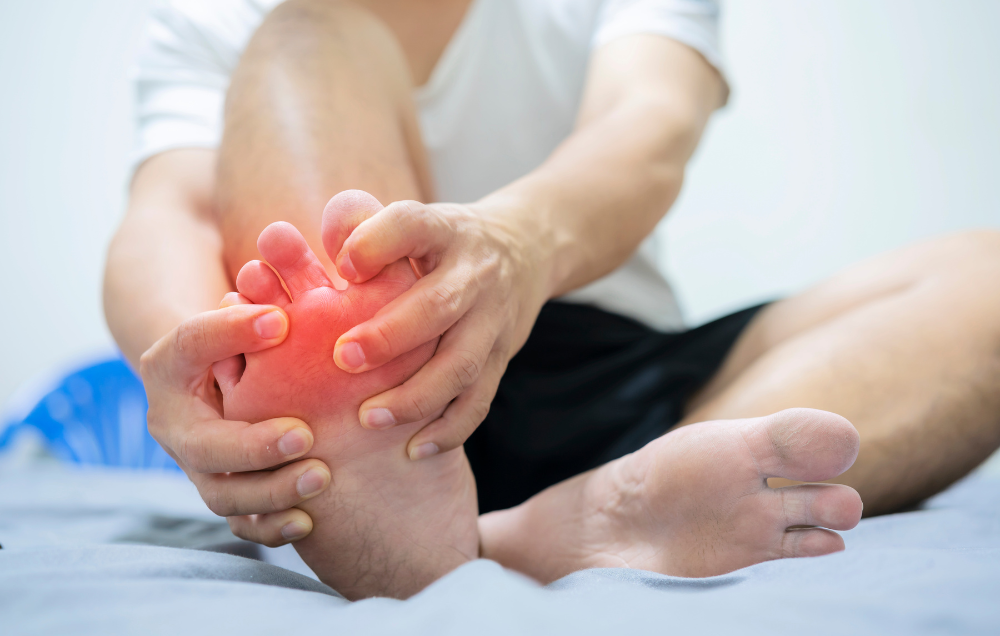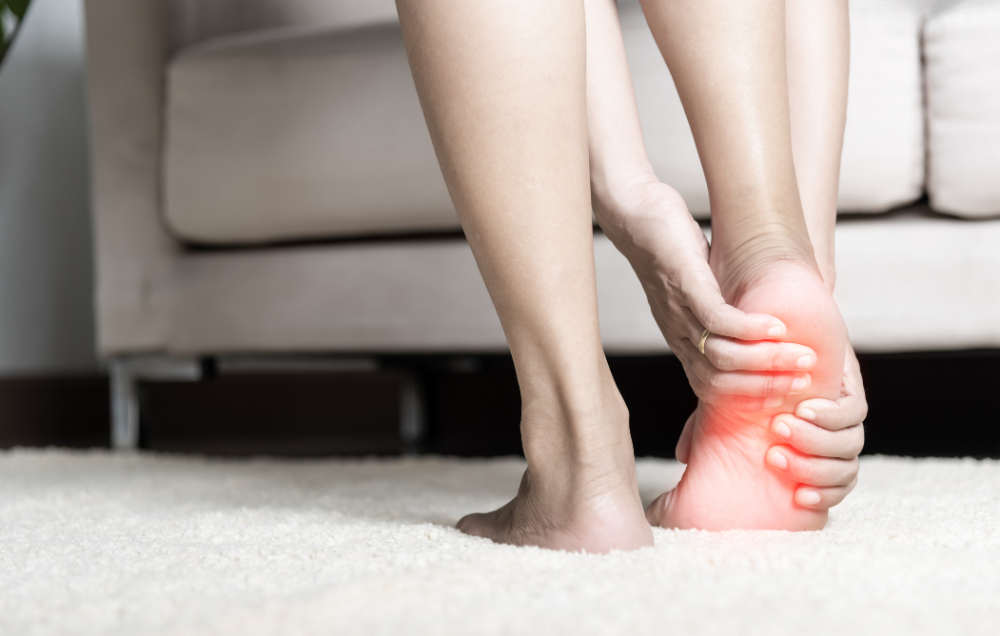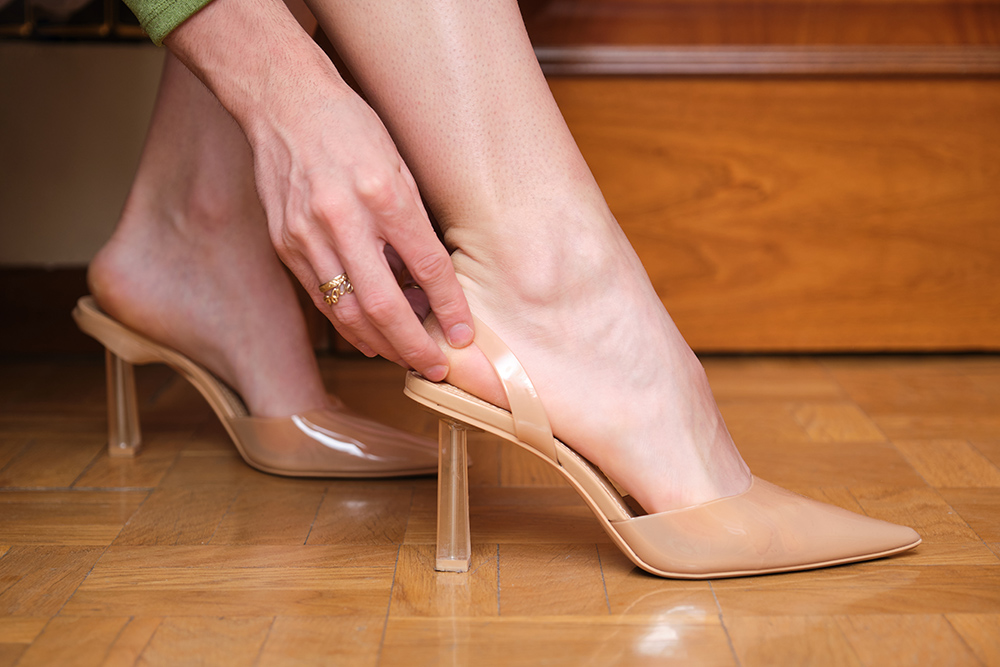Contents
Have you ever used a pedometer or a smartwatch to measure how many thousands of steps you take during an average day? Our feet and ankles take a lot of wear and tear compared to other parts of the body. Some people are more prone to foot pain than others. The shape of your feet, prior injuries or surgeries, the shoes you wear, and even the way you walk can all contribute to foot pain.
You don’t need to have a diagnosable condition to seek treatment for foot pain. However, whatever’s causing your foot pain, there’s likely an explanation and a way to treat it. Bunions, corns, plantar fasciitis and strains are all common overuse injuries that can cause foot pain. Stress fractures can form over time, and many people first notice pain from chronic conditions like arthritis or gout in their feet. Nerve pain and peripheral neuropathy are also common in the feet.
Physical therapy offers treatments for these types of musculoskeletal conditions that are natural and noninvasive, without the use of prescription medications or surgical procedures. A physical therapist uses their hands and other tools to manipulate tissue in a way that supports your body’s healing processes. Movement and stretching are usually important aspects of treatment. Your PT can also help you rehabilitate your feet for specific activities like sports or tasks you do for work. They can advise you on lifestyle changes, ergonomic devices, warmups and other things you can do for long-term pain management.
In this blog post, we’ll discuss some common causes of foot pain and outline nine physical therapy exercises that can help you improve your foot strength while reducing pain.
What types of physical therapy exercises can help with foot and ankle pain?
Foot and ankle pain is often a result of overuse or repetitive movement, which can cause tiny tears in soft tissue as well as tightness, stiffness, and formations like calluses or bone spurs. Physical therapy exercises for foot pain focus on stretching, strengthening, and recovering range of motion in different parts of the foot and lower leg. These activities break up stiffness, increase circulation and restore healthy movement in soft tissue. For areas that are particularly stiff or painful, you can also massage the area with gentle pressure.
9 physical therapy exercises for improving foot strength and reducing pain
Depending on what’s causing your foot pain, you may need some time to rest and recover before you start exercising. We recommend the RICE method for soft tissue injuries: rest, ice, compression and elevation. In some cases, alternating ice and heat can help. Apply an ice pack for about 20 minutes and then switch to a heating pad for another 20 minutes. Repeat as desired.
Most of the foot exercises in the list below can be done while sitting in a chair. For some of the stretches, you may want to lean against a wall for support. You’ll only need a few household items: a tennis ball or a baseball, a small towel, and some small items like marbles.
Try these nine physical therapy exercises to improve foot strength and reduce pain:
- Tennis ball roll — In a chair, put your tennis ball or baseball on the floor beneath the ball of your foot. Apply gentle pressure as you slowly roll it forward and backward, massaging the ball and arch of your foot. Repeat with the other foot.
- Toe raise, point and curl — Stay seated and put both feet flat on the floor. Raise your heels up until you’re resting on the balls of your feet. Hold this stretch for five seconds and then raise your feet up again so your toes are pointed and touching the floor. Hold for another five seconds. Finally, keep the tips of your toes on the floor while you point your heels out to each side and hold for five seconds.
- Ankle stretch — Rest one ankle on top of the opposite knee. Use your hands to stretch your ankle in all four directions for 10 seconds: Flex your foot back, point your toe, and then stretch to the left and the right. Repeat with the other foot.
- Ankle alphabet — Raise your right foot slightly and trace the letters of the alphabet with your big toe to work on range of motion. Put your right foot down and repeat with your left foot.
- Toe splay — You can do both feet at the same time or do the right and left foot separately. Slightly raise your feet and spread your toes out as wide as you can. Hold for about five seconds and repeat three times.
- Toe curls with towel — Lay a small towel in front of you, still seated in a chair. Use the toes of your right foot to grab the towel and pull it toward you; then bring it back to the starting position and release it back down. Repeat this several times and then switch to the left foot.
- Marble pickup — Place 10 small items, such as marbles, on the floor in front of you. Use your toes to pick them up and put them back down. You might put them in a container or draw a line on the floor and move them from one side to the other. Do two or three sets with each foot.
- Runner’s stretches — You’ll need to stand for the final two exercises. Stand so the toes of one foot are up against a wall and rest the other foot one big step behind you. Bend the knee of your back leg generously until you feel a stretch in your hamstring and hold for 15 seconds. Straighten your knee and stretch the back of your thigh for 15 seconds. Keep your back foot planted and point the toes of your front foot up so you’re resting on your heel. Stretch your calf muscle for 15 seconds and then repeat the set with the other foot.
- Calf raises — You may want to put a hand on the wall or a railing to help you stay balanced. Stand with your feet shoulder width apart and raise your heels up as far as you can, standing on the balls of your feet. Lower back down slowly and with control. Repeat for a set of 15 to 20 calf raises.
Get a personalized physical therapy plan with exercises for better foot health
If these exercises increase your pain or if your foot pain doesn’t go away within about a week, you should see a physical therapist. They’ll begin with a thorough assessment to learn about your symptoms and observe how your foot can currently function. Your PT will create a personalized treatment plan based on your condition and the activities you do on a regular basis. They may begin with some gentler treatments like manual therapy to stimulate movement and healing deep inside your foot. Once you’ve recovered some flexibility and movement, you’ll increase the amount of exercise and stretching you can do.
At Lattimore PT, we specialize in musculoskeletal conditions that cause foot pain such as bunions, plantar fasciitis, osteoarthritis and more. At all of our locations, we have at least one physical therapist with a Certification in Orthopedic Manual Physical Therapy (COMT). This means they have a higher level of expertise in assessing musculoskeletal problems and formulating a specific treatment plan for each patient.
Are you wondering if physical therapy can help with your foot pain? Contact our team today or schedule an appointment.



